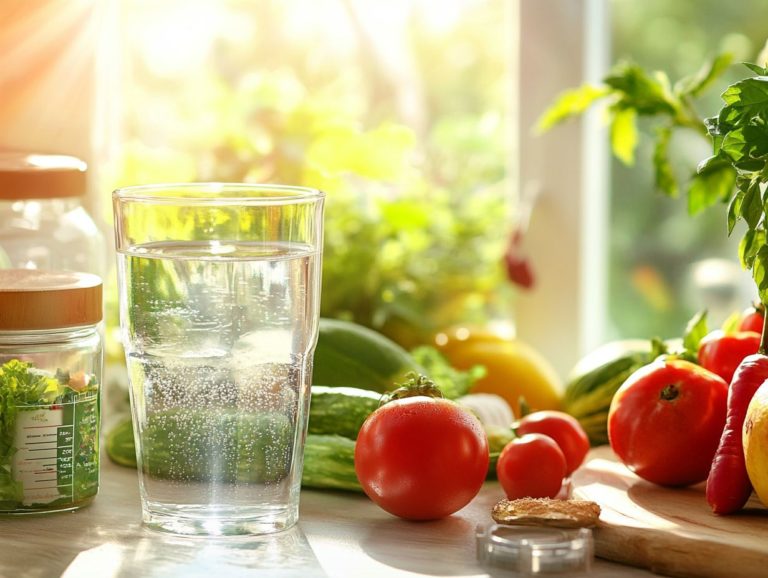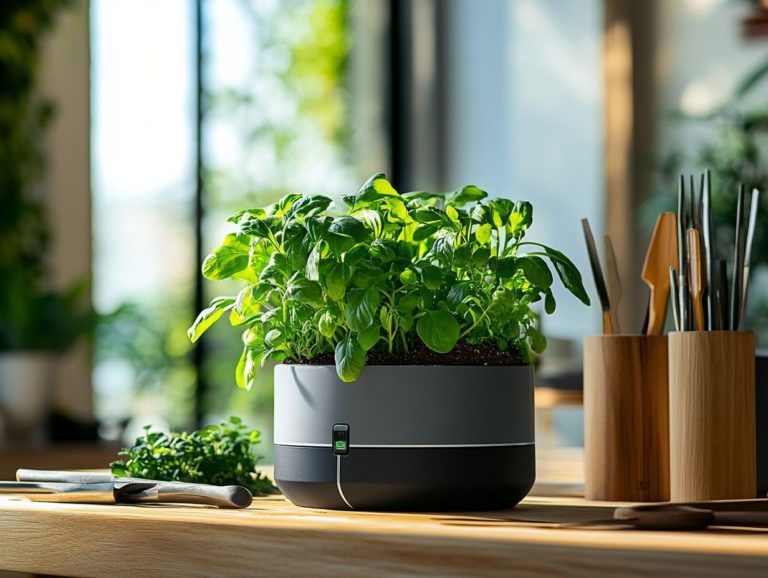Top 7 Mistakes in Watering Indoor Plants
Properly watering indoor plants is vital for their health and growth. Yet, many plant enthusiasts inadvertently fall into common mistakes that can lead to issues.
From the pitfalls of overwatering to overlooking the specific needs of newly repotted tropical plants, knowing these key points is essential for anyone eager to nurture a flourishing indoor garden.
Let s explore the top seven watering mistakes you can avoid to keep your plants thriving and happy throughout the year.
Contents
- Key Takeaways:
- 1. Overwatering
- 2. Underwatering
- 3. Using the Wrong Type of Water
- 4. Not Providing Adequate Drainage
- 5. Not Adjusting Watering Frequency for Seasonal Changes
- 6. Neglecting to Water Newly Repotted Plants
- 7. Watering on a Schedule Rather Than Based on Plant Needs
- Why Is Proper Watering Important for Indoor Plants?
- What Are the Signs of Overwatering and Underwatering?
- How Can One Determine the Right Amount of Water for Their Plants?
- What Are the Different Methods of Watering Indoor Plants?
- How Can One Prevent Common Watering Mistakes?
- What Are the Benefits of Using Filtered or Distilled Water for Plants?
- What Are Some Tips for Watering Specific Types of Indoor Plants?
- How Can One Revive a Plant That Has Been Overwatered or Underwatered?
- Frequently Asked Questions
Key Takeaways:
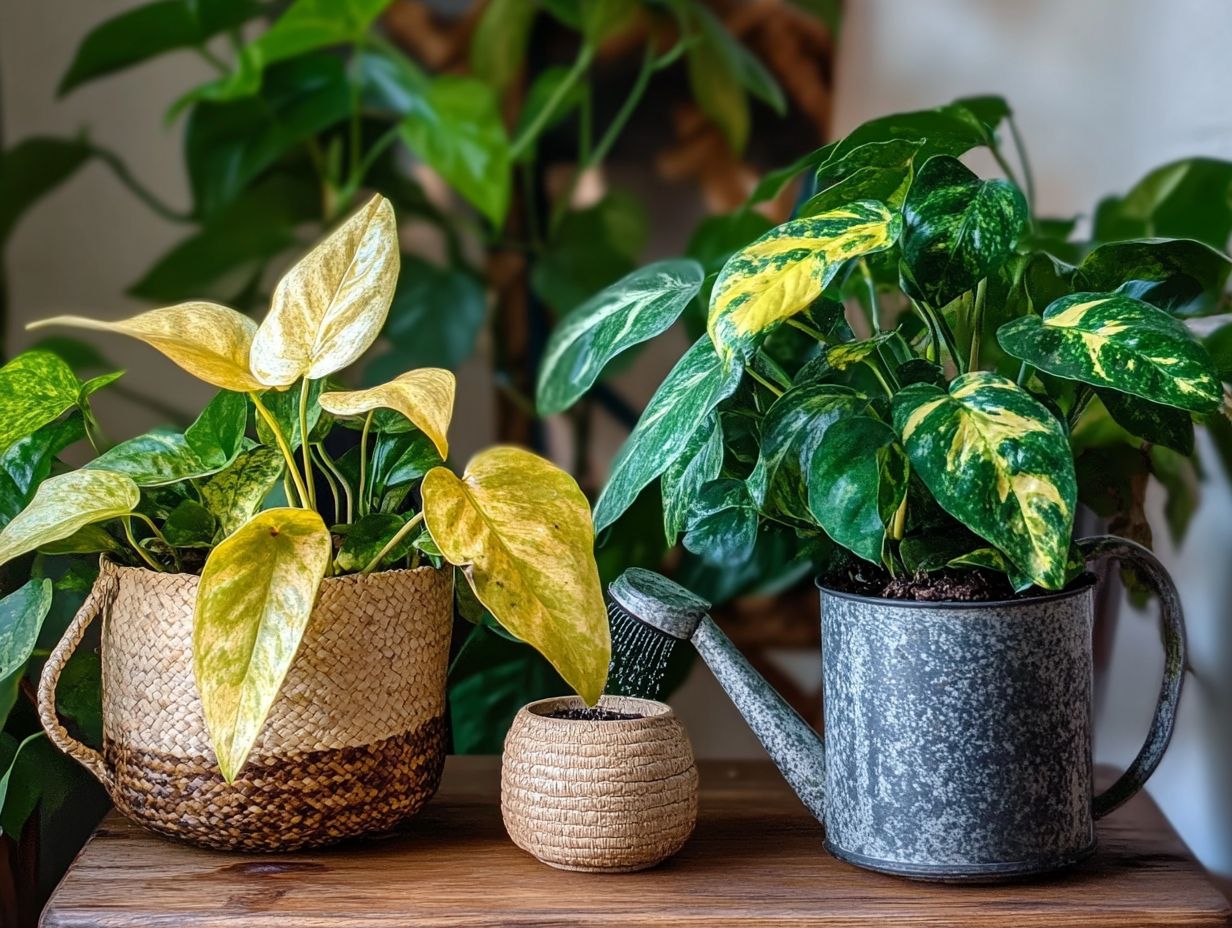
- Overwatering can be just as harmful as underwatering.
- Using the wrong type of water, such as tap water with high levels of chlorine, can be detrimental to your plants.
- Adjusting watering frequency based on seasonal changes and individual plant needs is crucial for thriving indoor plants.
1. Overwatering
Overwatering is a frequent mistake. It often leads to issues like root rot and yellowing leaves.
A clear sign of overwatering is the yellowing of leaves, indicating the roots are struggling to absorb nutrients due to excess moisture. This can lead to mushy roots and irreversible damage.
Allow the top inch of soil to dry out before rewatering. Choose pots with drainage holes to help excess water escape, preventing waterlogged conditions that can lead to pests.
Humidity plays a pivotal role in plant care. Many houseplants thrive in humid environments and require adjustments for light. Misting can elevate humidity levels without overwatering.
2. Underwatering
Underwatering can be just as detrimental as overwatering. It deprives your houseplants of the moisture they crave, resulting in yellowing leaves and stunted growth.
Signs of underwatering include dry soil that pulls away from the pot edges and wilting leaves that may curl or droop. To check moisture levels, insert a finger about an inch deep into the soil.
Different indoor plants have varying hydration needs. Succulents thrive on less frequent watering, while tropical plants require more consistent moisture. Establish a regular watering schedule while being attentive to each plant’s unique preferences.
A moisture meter can also be a valuable tool for ensuring your plants receive the right amount of care.
3. Using the Wrong Type of Water
Using the wrong type of water can significantly affect your plants’ health, especially if tap water contains harmful chemicals.
Opt for filtered or distilled water to minimize chemical buildup in the soil, particularly chlorine and fluoride. These contaminants can alter soil composition and impact water retention.
By choosing purer forms of water, you can maintain the right humidity around your plants. When you consider their specific needs, you’ll find that species like ferns or orchids thrive on distilled water, promoting a healthier overall environment.
4. Not Providing Adequate Drainage

Neglecting proper drainage in your plant pots can lead to water pooling, which can seriously stunt their growth. This creates a perfect breeding ground for root rot that stifles your indoor plants’ development, and it can also invite pests and diseases that thrive in those damp conditions.
Having adequate drainage holes is essential. They allow excess water to escape, promoting healthier root systems that can draw in the oxygen they need. You might want to incorporate materials like perlite or sand into your soil mix to enhance aeration and prevent compaction. This makes it easier for roots to penetrate and absorb vital nutrients.
By ensuring proper drainage and well-aerated soil, you can create an environment where your green companions truly thrive, resulting in vibrant foliage and robust growth.
5. Not Adjusting Watering Frequency for Seasonal Changes
Failing to adjust your watering routine with the changing seasons can create improper moisture levels, which can detrimentally impact the health and growth of your houseplants.
During the warmer months, as temperatures rise and humidity can vary, your plants may require more frequent watering to match their increased evaporation rates. Conversely, when the colder season arrives, the air often dries out, and plant growth tends to slow down, meaning they may need significantly less water.
Make it a priority to check the soil moisture levels regularly and adapt your watering schedule accordingly. You can use a moisture meter, a device that checks how wet your soil is, or simply test the soil with your finger for a reliable gauge of its dampness.
You can also maintain humidity levels with a humidifier or use pebble trays to help ensure your plants receive the right amount of moisture, encouraging healthier growth.
6. Neglecting to Water Newly Repotted Plants
Failing to water your newly repotted plants properly can significantly hinder their root establishment and consistent care, ultimately affecting their overall health.
Once you’ve completed the crucial task of repotting, it’s essential to provide consistent care to help your plants acclimate to their new environment. Keeping an eye on moisture levels is key, as the roots will be unfamiliar and quite sensitive to changes in soil moisture. Tools like moisture meters can be invaluable, helping you determine the perfect time to water ensuring your plants neither dry out nor become waterlogged.
Adjusting your watering schedule based on factors such as humidity, temperature, and light requirements will support healthy adaptation. This attentive approach encourages robust root development and fosters resilience, significantly enhancing your plants’ long-term vitality.
7. Watering on a Schedule Rather Than Based on Plant Needs
Relying exclusively on a rigid watering schedule instead of tailoring it to each plant’s individual needs can easily lead to the pitfalls of overwatering or underwatering, jeopardizing their health.
It’s essential to observe your plants closely for signs of stress; even the slightest changes like wilting leaves or discolored foliage can signal that something is wrong.
Keep in mind that environmental factors play a significant role in this balance. For example, varying light levels can either accelerate or slow down soil evaporation, while humidity can either trap moisture or contribute to dryness. Therefore, it s crucial to consider these conditions when deciding how often to water.
Embracing a flexible approach will enhance your hydration practices, ensuring that each plant receives the precise care it needs to thrive.
Why Is Proper Watering Important for Indoor Plants?
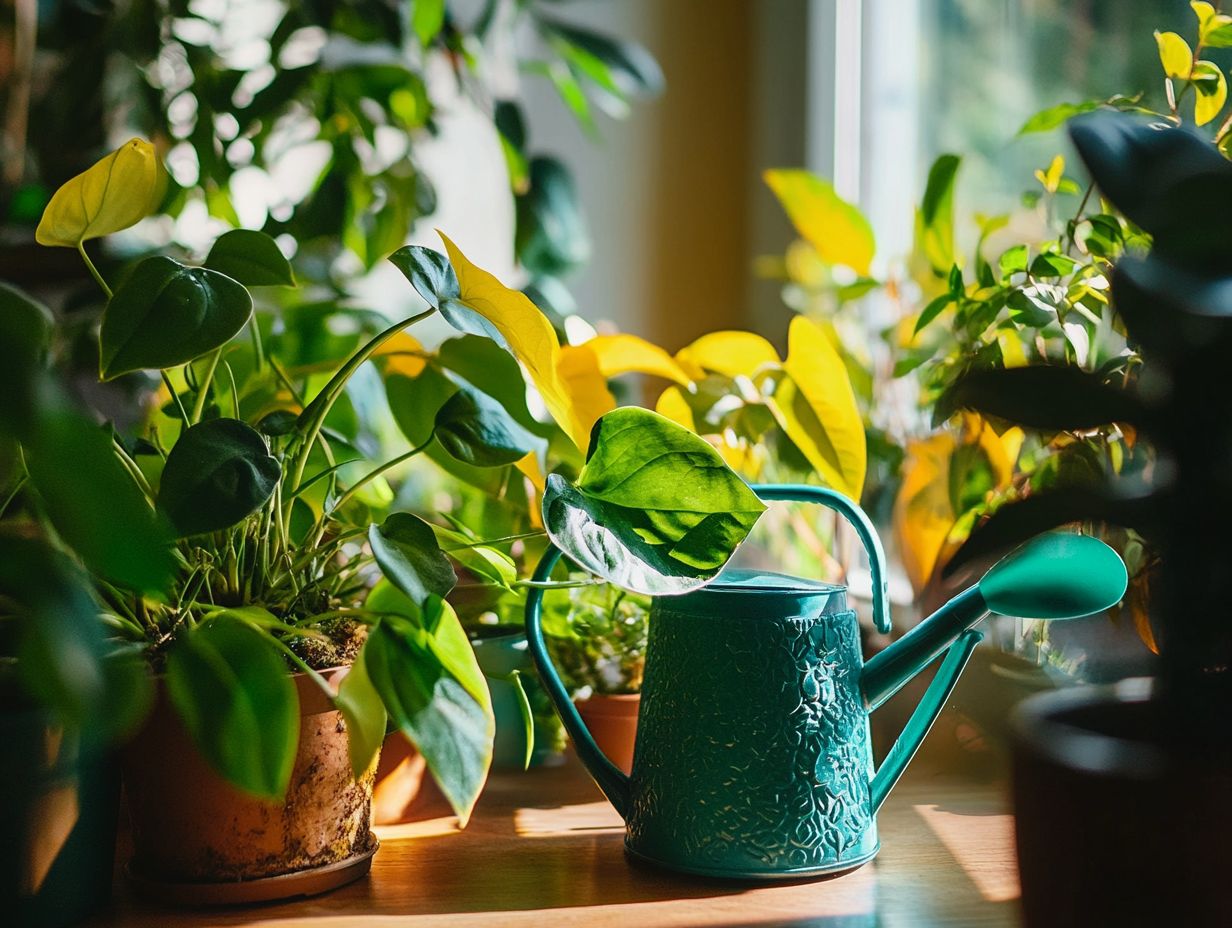
Proper watering is essential for your indoor plants. It directly influences their growth and overall health, helping them resist pests and flourish in their unique environments.
Water plays a critical role in taking in nutrients, which is vital for plant health. It acts as a solvent that allows plants to absorb important minerals and nutrients from the soil. Water is also crucial in the process plants use to make food from sunlight, providing the necessary medium for chemical reactions that fuel new growth.
Your watering practices directly affect humidity levels. Maintaining appropriate humidity helps prevent extreme conditions that could stress your plants. Avoiding common mistakes is key to keeping your plants thriving! For guidance on this, check out the top 7 tips for indoor plant care troubleshooting. Overwatering or underwatering can lead to health issues like root rot, nutrient deficiencies, or stunted growth, all of which threaten their vitality.
What Are the Signs of Overwatering and Underwatering?
Recognizing the signs of overwatering and underwatering is crucial for your houseplants’ health. Here are some symptoms to look out for:
- Yellowing leaves
- Wilting
- Drooping leaves that feel soft and mushy (indicating overwatering)
- Crisp, brown edges on leaves (indicating underwatering)
- Soil pulling away from the pot’s sides (a sign of underwatering)
In extreme cases, overwatered plants can develop root rot, causing leaves to turn yellow and drop off. Conversely, an underwatered plant may curl its leaves in a desperate attempt to conserve moisture.
Paying attention to these visual cues will empower you to provide the best care for your green companions.
How Can One Determine the Right Amount of Water for Their Plants?
Determining the right amount of water for your houseplants involves understanding their individual needs, the environmental conditions they inhabit, and the moisture levels present in the soil.
You have effective methods for gauging soil moisture. Consider using moisture meters for precise readings or simply conduct a finger test insert your finger into the soil to check for dampness.
Recognizing that different plants have unique watering requirements enables you to tailor your practices accordingly. For example, succulents thrive on infrequent watering, while tropical plants prefer consistently moist soil. By observing these needs, you can foster healthier plant growth and avoid common pitfalls.
What Are the Different Methods of Watering Indoor Plants?
There are several methods for watering indoor plants, each tailored to suit different plant types and moisture needs:
- Bottom watering: This allows your plants to soak up moisture through their drainage holes, ideal for those that need consistent hydration.
- Watering can: This gives you precise control over the amount of water you distribute but can sometimes result in uneven moisture levels.
- Self-watering pots: These provide your plants with access to water as needed, though they require regular monitoring to prevent stagnation.
Ultimately, the best watering method will depend on each plant’s unique requirements and your personal lifestyle.
By mastering the art of watering, you can ensure your indoor plants thrive, bringing joy and life to your space!
How Can One Prevent Common Watering Mistakes?
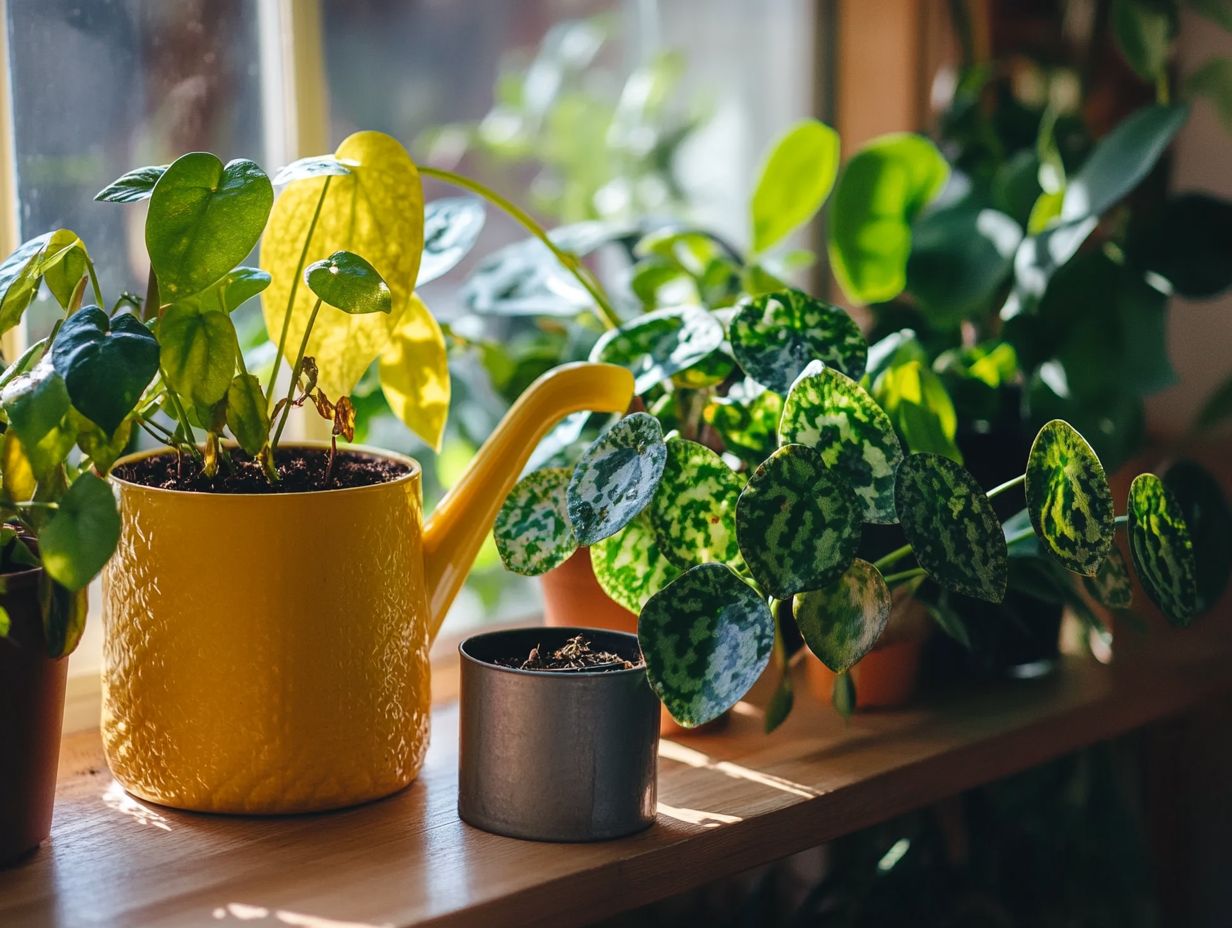
Preventing common watering mistakes demands attention, a solid understanding, and often a bit of research tailored to the unique needs and environments of each houseplant.
To effectively reduce the risk of over or under-watering, it’s imperative to select the right pot that offers adequate drainage and maintains the suitable moisture level for your plant’s species. Keeping an eye on humidity levels is essential because fluctuating indoor climates can greatly influence how much water your plant absorbs. For more insights, check out common missteps in indoor plant care.
Adjust your care routine according to seasonal changes, like cutting back on watering during the winter months when many plants enter dormancy. This ensures that each houseplant receives the optimal care it deserves throughout the year.
What Are the Benefits of Using Filtered or Distilled Water for Plants?
Using filtered or distilled water for your houseplants comes with numerous benefits, including a reduction in chemical buildup in the soil and the promotion of healthier growth.
When your plants encounter contaminants often lurking in tap water like chlorine, fluoride, and heavy metals their growth can suffer, resulting in weak stems and yellowing leaves. This can hinder their ability to thrive and fend off pests or diseases.
Choosing filtered or distilled water eliminates these harmful substances, allowing your plants to absorb essential nutrients more effectively. You ll be amazed at the transformation in the overall vigor and resilience of your plants, enabling them to flourish beautifully in any indoor setting.
What Are Some Tips for Watering Specific Types of Indoor Plants?
Watering specific types of indoor plants requires specific care to meet their unique needs, including humidity levels and light preferences.
Take the Fiddle-Leaf Fig, for example; it thrives in bright, indirect light and enjoys its soil drying out slightly between waterings. A bi-weekly hydration schedule is often perfect for this beauty.
In contrast, the Snake Plant is quite the easygoing companion, requiring minimal water. It s prone to rot if overwatered, so just a trickle every few weeks adjusting for the season will do the trick.
Then there are Orchids, which have their own specialized watering routine. They flourish when watered thoroughly but need to dry out before the next session, usually requiring your attention every 10 to 14 days. Understanding these nuances helps you cultivate a healthier, thriving indoor ecosystem.
How Can One Revive a Plant That Has Been Overwatered or Underwatered?
Reviving a plant that has suffered from overwatering or underwatering demands prompt and effective adjustments to your care routine. Focus on restoring proper hydration levels and overall vitality.
Start by assessing the current moisture of the soil; if it feels soggy and emits a foul odor, it’s a clear sign of overwatering. In this case, reduce the frequency of watering and allow the soil to dry out before you pick up the watering can again.
On the flip side, if the soil is bone dry, a thorough soaking is in order, but ensure that excess water can escape to prevent further issues. Repotting might become necessary, particularly if you notice signs of root rot or if the roots are tightly bound.
Keep a vigilant eye on the leaves, as they can offer critical insights watch for signs of new growth or any color changes. These indicators will help you track your plant s recovery progress and ensure it s on the right path back to health.
Frequently Asked Questions
Start watering your plants correctly today for a healthier indoor garden!
What are the top 7 common mistakes people make when watering their indoor plants?
1. Overwatering: This is the most common mistake. It can cause the roots to decay and kill your plant.
2. Underwatering: Not giving enough water leads to dehydration. Watch for wilting and yellowing leaves!
3. Using the wrong type of water: Some plants dislike chemicals in tap water. Use filtered or distilled water for sensitive types, especially tropical plants.
4. Improper drainage: If your pot lacks drainage holes, water can gather and suffocate the roots. This can lead to decay.
5. Inconsistent watering schedule: Stick to a regular schedule. Your plants will love the routine!
6. Watering at the wrong time of day: Water in the morning or late afternoon. Midday watering causes evaporation and leaves roots thirsty.
7. Not checking the soil moisture: Always check if the top inch of soil is dry before watering. Adjust your watering based on your plant s needs.

